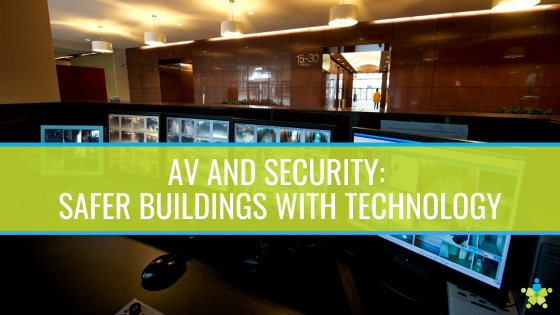Security is a priority for building managers. Whether it's a school, an office building, a hospital or something else, more facility managers are turning to AV solutions for better security.
AV's role in this area is still being developed, but its influence is growing. AV technology can play a role in multiple aspects of security, from deterrence to response. Here, we'll take a look at how AV can improve your facility's security and safety, at every level.
The Four Objectives of Building Security and the AV Technologies That Support Them
Facility security rests on four principles. They include:
- Deterrence - Security measures that deter an intruder keep them from gaining access in the first place. This term is usually applied to physical security, but it can also be associated with cybersecurity measures. In both cases, deterrence technology is designed to stop a security threat before it begins.
- Detection - If an intruder does gain access to the facility, quick detection is key to minimizing any damage they may cause. That's what detection-based technologies do - notice when an unauthorized person has gained entry, and alert building personnel.
- Prevention - While deterrence is typically used to refer to physical security, prevention is used in a cybersecurity context. Specifically, technologies that prevent intrusion slow down an intruder's attempts to access data or sensitive hardware.
- Response - If an active situation is underway, a prompt response may neutralize the intruder before they have a chance to do harm. There are several technologies that can help with a facility's response and make it difficult for an intruder to evade capture.
Next, we'll address how AV technology can support all four pillars of this security strategy.
Deterrence: Video Surveillance and Single Point Access and AV Communication
Ideally, security threats are deterred before the threat is realized. This is fertile ground for technological development, as decision makers look for ways to secure schools, universities and other potential targets.
Video surveillance remains an effective (and cost effective) deterrence technology, reminding would-be criminals that their actions are being watched. If your video cameras are tied to smart lighting controls, your cameras will remain effective at night. In fact, they may be more effective, as criminals may not see the camera until they are in range of being captured on video.
Single point access is quickly gaining traction among schools and apartments, as it forces all visitors to enter through a single, monitored entry point. A proven way to implement this is to set up an airlock-style, double door access point. When people enter through the first set of doors, a two-way communication system (many with audio and video) is used to interact with each visitor. If there are any concerns about a particular person, building personnel can keep the doors locked and alert security to a potential threat.
Detection: Instant Alarm Systems and Forced Entry Detection and Occupancy Controls
Modern locking systems can be programmed to automatically lock at certain times and detect when someone has forced their way through the door. Forced entry detection can be tied to building security systems so security knows exactly when and where someone has gained unauthorized access to the facility. Occupancy controls can also serve in this role, by detecting IR or motion, and sending an alert when someone is detected in an unauthorized area or during an unauthorized time.
Another way to quickly alert an entire building is to equip employees with panic buttons. In schools, for example, panic buttons can be integrated into worn microphones that teachers carry with them. If they spot an intruder or if a student becomes a threat, pushing the button sends an instant alert to the front office and security personnel. If programmed, pushing a panic button can also trigger the building's alarm systems.
Prevention: Better Password, Data and Hardware Protection
Cybersecurity and data security are quickly becoming critical aspects of organizational security. Prevention starts with having the right software solutions in place, like antivirus software, firewalls, and other forms of network protection.
Improved access control is also recommended. This could be as simple as training personnel on better password creation, or it could be as complex as installing biometric scanners and short-lived security tokens.
Don't forget about the physical aspect of cybersecurity, either, as this prevents access to the hardware that contains your organization's data. Timed and remote locking systems are an effective security measure, as are hardware cabinet locking systems and the use of covers to shield your surveillance cameras from view.
Response: Digital Signage, Remote Access Control and Building-Wide Communication
If your facility is breached by an intruder, an immediate response can still stop the threat before it causes significant harm. Response technologies include both remote and automatic locking systems. If programmed, all of your building's electronic locks can be primed to engage as soon as an alert is sounded.
Digital signage can also play a response role. Whether it's an active intruder situation or severe weather, the building's digital signage can be used to display emergency alerts and instructions to the building's occupants.
Individual displays, or groups of displays, can be used to communicate with specific rooms or parts of the building. This can be used to send direct instructions and updates to people who are locked down. The digital signage can also be used to guide emergency responders when they arrive at the building.
AV Can Empower Security Personnel and Practices with Technology Solutions
The future of facility security relies on technology. AV technology solutions improve security in several ways. They deny access, deter criminal activity, give security personnel better monitoring capabilities, and enhance response.
Better security is built in layers and must account for everything, including physical and network points of access, better credential upkeep, response procedures, and constant facility monitoring.
AV solutions can support all of those measures, and your facility's overall security strategy.



